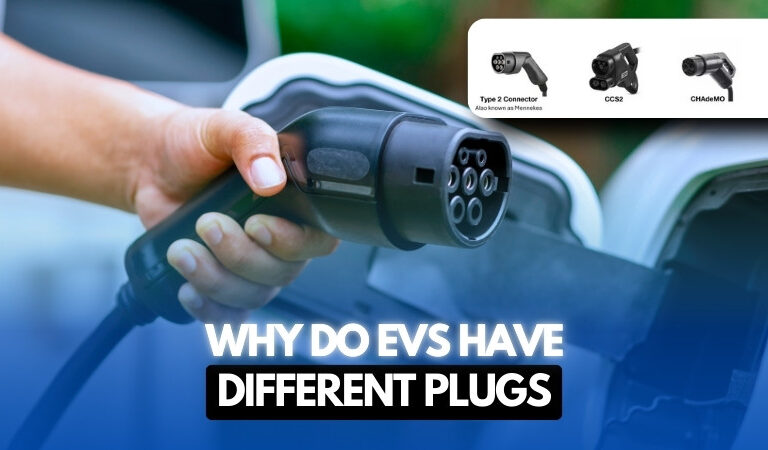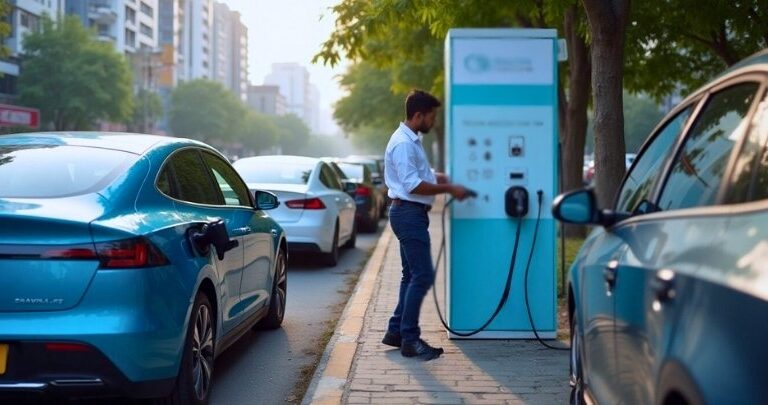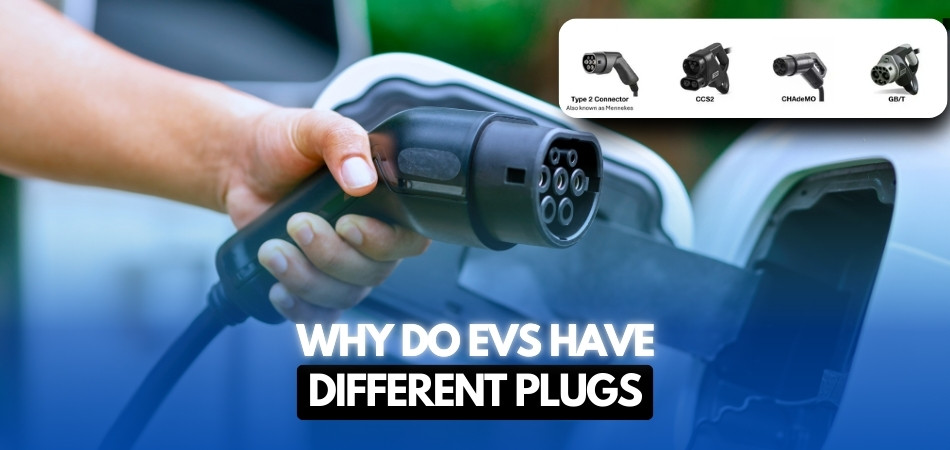Electric vehicles, also known as EVs, are becoming more popular because they are better for the environment. But if you look closely, you’ll see that not all EVs charge the same way. Some have different plugs, and not every plug fits every car. This can be a bit confusing.
So, why do EVs have different plugs?
The main reason is that EVs come from different countries. For example, cars from Japan often use CHAdeMO plugs, while cars from Europe use Type 2 or CCS plugs. In Bangladesh, there is no single rule for EV plugs, so many different types are used across charging stations.
Want to know how this affects EV users and what it means for the future? Keep reading to find out!
Why Do EVs Have Different Plugs?
Electric vehicles (EVs) are becoming more common across the world. But many people get confused when they see different plug types. This is because not all EVs use the same kind of charger.

Regional Charging Rules Are Not the Same
Different areas created their own plug styles based on local car models and charging needs. North America mostly uses Type 1 plugs, while Europe chose Type 2. This causes plug differences when cars are imported from one place to another.
In Asia, some cars come with Japanese plug systems like CHAdeMO, while others follow European or American models. That’s why countries like Bangladesh see many plug types. Local stations try to match all these plug types for better support.
Every region made its own rules before global standards were discussed. Because of this, plug types developed separately without working together. This leads to confusion for drivers using different charger systems in the same area.
Plug Type Depends on Charging Speed
Some plugs are made for slow charging, and others are for fast charging. Type 1 and Type 2 work well for home or slow public charging. But plugs like CHAdeMO and CCS are made for fast charging at special stations.
Fast charging needs more power, so it requires a different plug design. This is why not all EV plugs look the same. The speed also depends on how the battery and charger talk to each other.
If your car supports fast charging, you’ll need a plug that fits high-power stations. That’s why different stations offer more than one plug. It helps all kinds of EVs connect and charge safely.
Different Brands Use Different Plugs
Car companies also choose what plug they want to use. Tesla used to have its own plug, which only worked with Tesla chargers. But now, Tesla is switching to CCS plugs in Europe for easier access.
This change helps Tesla drivers use more public chargers. It also reduces the number of plug types on the market over time. Still, some older models will keep using the older plugs for a while.
Each company picks plugs based on their design and where they sell cars. That’s why cars from different brands don’t always use the same connector. More companies are now moving toward using common plugs like CCS.
Older Cars Still Use Old Systems
When EVs first came out, there were only a few plug types available. Some of those early plug designs are still around today. A good example is the first Nissan Leaf, which uses the CHAdeMO plug.
Even though newer systems are better, older EVs still need to charge with what they were built for. So stations must keep supporting these older plugs. It keeps older car owners from having to buy new cars too soon.
As time goes on, these old systems will slowly go away. But for now, charging stations still include them to help every driver. That’s why the plug types haven’t fully changed yet.
EV Charging Is Not Standard Yet
The world is moving toward fewer plug types, but it will take time. Most companies now agree that CCS should be the main fast charger. But switching all cars and stations is a long process that needs planning.
In places like Bangladesh, many EVs are imported with different plug systems. That’s why you’ll find more than one plug type at an electric vehicle charging station in Bangladesh, making things flexible for all drivers.
Governments and companies are working on creating better rules for plug use. When that happens, drivers won’t need to worry about plug types. Until then, we’ll keep seeing many different charger styles.
Do EVs Need Different Plugs to Charge?
Yes, EVs do need different plugs to charge. This happens because not all electric vehicles are made the same way. Different companies and countries use different plug styles for their own reasons. These differences affect how fast the car charges and where it can be plugged in.
Some cars from Japan use one plug, while others from Europe or the U.S. use another type. Charging stations must offer many plug types so all cars can use them. That’s why you might see four or five plug designs at a single charging point. Drivers need to know their car’s plug type before choosing a charger or traveling far.
What Plug Types Are Common in Bangladesh?
Electric vehicles (EVs) are now seen more often on the roads of Bangladesh. But not every EV uses the same plug type. Since most EVs are imported, different charging connectors are found across the country. It’s helpful to know the most used plugs in local charging stations.

CHAdeMO
Many Japanese EVs in Bangladesh use the CHAdeMO plug for fast DC charging at public stations or private homes. This type works well with older models like the early Nissan Leaf, which is still very common here. Drivers choose CHAdeMO because it’s reliable and often available at used vehicle import points. Charging stations try to include this plug so those cars can charge without any trouble.
Type 2 (Mennekes)
European cars usually come with the Type 2 plug, which supports both slow and medium-speed AC charging modes at many locations. It is widely used for home and public charging in European-built EVs like BMW or Renault models. Type 2 plugs are easy to handle, making them a good choice for daily use. Many local stations incities support this plug due to rising imports from Europe.
CCS (Combined Charging System)
Newer EVs often use CCS plugs that allow both AC and DC charging from the same connector depending on the charger. Most high-end cars now support CCS because it charges quickly and is future-ready with global support. Since more brands are switching, CCS stations are slowly spreading across major urban areas. To improve EV plug compatibility, many charging points offer both CCS and other common plugs.
Type 1 (J1772)
Some American or older Asian imports may come with the Type 1 plug, mostly used for slower AC home charging. While not as common as others, a few EVs on the roads still require this connector type. Owners usually get adapters or install home charging setups for easier use with their vehicle. Though not popular, this plug type is still part of the country’s charging mix.
Electric vehicles are becoming popular in Bangladesh, but charging plugs vary widely because many cars come from different countries. Common types include CHAdeMO for older Japanese models and Type 2 for European cars. New CCS plugs are growing in cities as they charge faster and work worldwide. Some older EVs use Type 1 plugs, so owners often install an electric vehicle charging station at home in Bangladesh for easier charging. Drivers must check their car’s plug type to find the right station.
How Mixed Plug Types Create Challenges & Ways to Fix it?
It’s great to see more electric cars on the road, but some things still feel a little tricky. One big issue many drivers notice is with charging, especially when plug types don’t match. It’s frustrating when you reach a station and find your plug doesn’t fit. Let’s look at why this happens and what can be done to make things better.

Different Cars, Different Plugs
Not all EVs use the same kind of plug because they come from different countries and car companies. A car from Japan might have a CHAdeMO plug, while a European car uses CCS or Type 2. When stations don’t offer the right plug, some cars get left out. This can make charging stressful for drivers who just want to top up and go. It also makes it harder to plan long trips without worries.
Charging Station Confusion
Many charging spots now offer multiple plug types, but that doesn’t always solve the problem. Sometimes the plug you need is already being used by someone else. Other times, a station might not have your plug at all. That can waste time and even lead to long waits. Drivers need to know in advance if the station will work for their car.
Costs Go Up
Because stations need to support many plug types, building them costs more money. Each plug type means different equipment, more wiring, and extra space. This can slow down how fast new stations are built. Some companies don’t want to pay for every type of plug, so they only support a few. That leaves out some drivers who have older or less common plug styles.
Hard for New Drivers
If someone buys their first electric car, they might feel confused by all the plug options. It’s not like a phone charger where most plugs look the same. You have to learn which plug your car uses and where to find it. That learning curve can make people nervous about switching to EVs. A simple system would make everything feel less scary and more friendly.
Trouble with Safety
Using the wrong plug or forcing one to fit can lead to safety problems. That’s why clear plug labels and proper instructions are so important. Some people try to use adapters that aren’t made well, and that can be risky. This is one of the hazards of EV charging stations that people often ignore until something goes wrong. Safety should always come first at charging points.
Lack of Rules
One big reason this plug mess exists is because there are no clear rules for all cars and stations. Every company and country just picked what worked best for them. Now we’re stuck with too many choices and no main standard. If a rule was made to use fewer plug types, things could improve fast. Governments and companies need to work together on this.
Moving Toward One Plug
Good news — many car makers are now choosing CCS plugs as the main one for fast charging. It’s not perfect yet, but it’s a big step toward fewer plug problems. The more cars and stations switch to one system, the easier it gets for everyone. This won’t happen overnight, but the process has already started. In the future, charging could be as easy as plugging in and walking away.
The Future of EV Charging in Bangladesh
Electric cars are becoming more common in many parts of Bangladesh. More people are using EVs for school, work, and travel. But to keep them running, we need more charging stations in the right places. Here’s what the future of EV charging might look like, in a simple way:
- Charging stations will be added near markets, schools, and bus stops so people can charge easily during daily trips.
- Local companies may work with foreign brands to build smart charging points that show plug types and charging time.
- Faster chargers will come to busy roads and highways so people can charge quickly while traveling between cities.
- These fast stations will reduce waiting time and help drivers know when a plug is free or in use.
- Solar power might be used at some charging points, especially in villages where electricity is not always strong.
- This will save energy, lower costs, and help the environment by using clean power from the sun.
- The government may choose one or two main plug types for all EVs to make things less confusing.
- This way, all drivers can charge their cars without checking if the plug will fit.
- More people will charge their cars at home using small wall chargers that are easy to install and use.
- Home charging will help save time and give drivers the chance to charge while they sleep.
- Special apps will help drivers find nearby charging stations and check how long they need to wait.
- These apps can also show battery levels and help plan trips without worry.
- New training centers may teach young people how to fix and manage EV chargers in different parts of the country.
- These jobs will help the EV system grow and give people useful skills for the future.
Frequently Asked Questions about Different EV Plugs
Electric vehicles (EVs) are great for the environment, but charging them can sometimes be confusing. One common question is about plug types. Here are some useful FAQs that help explain why EVs don’t all use the same plugs.
What Makes EV Plug Designs So Different?
Each plug type was designed based on country needs, car company choices, and charging speed levels. That’s why plug shapes, sizes, and pins often vary, depending on how the car and charger work together.
Do Plug Types Depend On Car Brands?
Yes, many car brands use different plugs based on their design and target market. Tesla, for example, used its own plug but now supports CCS in some regions to make charging easier for its drivers.
Why Don’t EV Makers Use Just One Plug Type?
EV makers started with different ideas before a common plug could be chosen. Some used older plugs that still work, while others now move to newer, faster charging options that meet modern driving needs.
Are Plug Types Based On Charging Speed?
Yes, some plugs like Type 1 and Type 2 support slow charging, while CCS and CHAdeMO are made for fast charging. The plug type depends on whether the car charges with AC or DC power.
Do Older EVs Use The Same Plugs As New Ones?
Older EVs usually use plugs like CHAdeMO or Type 1, which were popular before. Newer EVs often support CCS or Type 2, so both old and new plug types are still seen at charging stations.
Can I Change My EV Plug Type?
You can use an adapter in some cases, but not all plugs work safely with every car model. Always check the car manual or charger label to avoid damaging the battery or causing charging problems.
Will All Cars Use The Same Plug In The Future?
Many companies are now switching to CCS for fast charging, and it may become the global standard. But it will take time, since older EVs still need their original plug types to charge properly.
Do Plug Types Affect Charging Costs?
Yes, fast charging plugs like CCS often cost more to use because they deliver power quickly. Slower plugs may be cheaper but take more time, so the plug type can affect both time and money.
Closing Remarks
Electric cars are becoming more common in Bangladesh, but charging them can still be a little tricky. One of the main problems is that not all EVs use the same plug. That’s why do EVs have different plugs — because cars come from different countries and companies with different systems.
This makes it harder for drivers to find the right charger for their car. It can also cost more to build charging stations with many plug types. But things are starting to get better. If more rules are made and stations use the same plug types, charging will become much easier for everyone.

